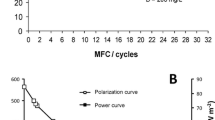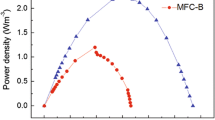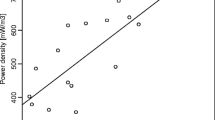Abstract
For the first time, a microbial fuel cell has been developed using an acidophile, Acidiphilium cryptum, as the anode biocatalyst. Electricity production using its natural electron acceptor, iron, as the electron mediating agent at pH values ≤4.0 was demonstrated. Accumulation of Fe(III) at the electrode, however, restricted current output. The combination of nitrilotriacetic acid and Phenosafranin as electron mediators increased the power output to 12.7 mW/m2 in a two-chamber air-sparged fuel cell. Direct electron transfer from the microorganisms to the anode was also investigated but was not detected under the conditions studied.






Similar content being viewed by others
References
Allen RM, Bennetto HP (1993) Microbial fuel-cells – electricity production from carbohydrates. Appl Biochem Biotechnol 39:27–40
Bilgin AA, Silverstein J, Jenkins JD (2004) Iron respiration by Acidiphilium cryptum at pH 5. FEMS Microbiol Ecol 49:137–143
Bilgin AA, Silverstein J, Hernandez M (2005) Effects of soluble ferri-hydroxide complexes on microbial neutralization of acid mine drainage. Environ Sci Technol 39:7826–7832
Bond DR, Lovley DR (2003) Electricity production by Geobacter sulfurreducens attached to electrodes. Appl Environ Microbiol 69:1458
Bretschger O, Obraztsova A, Sturm CA et al (2007) Current production and metal oxide reduction by Shewanella oneidensis MR-1 wild type and mutants. Appl Environ Microbiol 73:7003–7012
Chaudhuri SK, Lovley DR (2003) Electricity generation by direct oxidation of glucose in mediatorless microbial fuel cells. Nat Biotechnol 21:1229–1232
Gil GC, Chang IS, Kim BH et al (2003) Operational parameters affecting the performance of a mediator-less microbial fuel cell. Biosens Bioelectron 18:327–334
Gorby YA, Yanina S, McLean JS et al (2006) Electrically conductive bacterial nanowires produced by Shewanella oneidensis strain MR-1 and other microorganisms. Proc Natl Acad Sci USA 103:11358–11363
Kim JR, Min B, Logan BE (2005) Evaluation of procedures to acclimate a microbial fuel cell for electricity production. Appl Microbiol Biotechnol 68:23–30
Kusel K, Dorsch T, Acker G, Stackebrandt E (1999) Microbial reduction of Fe(III) in acidic sediments: isolation of Acidiphilium cryptum JF-5 capable of coupling the reduction of Fe(III) to the oxidation of glucose. Appl Environ Microbiol 65:3633–3640
Kusel K, Roth U, Drake HL (2002) Microbial reduction of Fe(III) in the presence of oxygen under low pH conditions. Environ Microbiol 4:414–421
Logan BE, Regan JM (2006) Electricity-producing bacterial communities in microbial fuel cells. Trends Microbiol 14:512–518
Logan BE, Hamelers B, Rozendal R et al (2006) Microbial fuel cells: methodology and technology. Environ Sci Technol 40:5181–5192
Logan B, Cheng S, Watson V, Estadt G (2007) Graphite fiber brush anodes for increased power production in air-cathode microbial fuel cells. Environ Sci Technol 41:3341–3346
Lovley DR (2006) Microbial fuel cells: novel microbial physiologies and engineering approaches. Curr Opin Biotechnol 17:327–332
Oh S, Min B, Logan BE (2004) Cathode performance as a factor in electricity generation in microbial fuel cells. Environ Sci Technol 38:4900–4904
Tanaka K, Vega C, Tamamushi R (1983) 6,12-bis-Thionine and ferric chelate compounds as coupled mediatorts in microbial fuel cells. Bioelectrochem Bioenerg 11:289–297
Acknowledgments
This research was sponsored by the Laboratory Directed Research and Development Program of Oak Ridge National Laboratory (ORNL), managed by UT-Battelle, LLC, for the US Department of Energy under Contract No. DE AC05-00OR22725. The authors would like to thank Choo Hamilton for technical assistance with A. cryptum and Barbara Evans and Babu Raman for reviewing the manuscript. S. C. would like to acknowledge partial financial support from Oak Ridge Associated Universities.
Author information
Authors and Affiliations
Corresponding author
Additional information
The submitted manuscript has been authored by a contractor of the US Government under contract No. DE-AC05-00OR22725. Accordingly, the US Government retains a nonexclusive, royalty-free license to publish or reproduce the published form of this contribution, or allow others to do so, for US Government purposes.
Rights and permissions
About this article
Cite this article
Borole, A.P., O’Neill, H., Tsouris, C. et al. A microbial fuel cell operating at low pH using the acidophile Acidiphilium cryptum . Biotechnol Lett 30, 1367–1372 (2008). https://doi.org/10.1007/s10529-008-9700-y
Received:
Revised:
Accepted:
Published:
Issue Date:
DOI: https://doi.org/10.1007/s10529-008-9700-y




